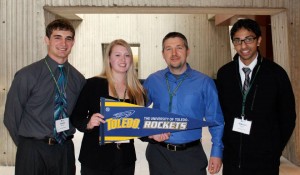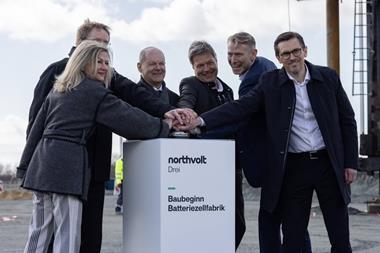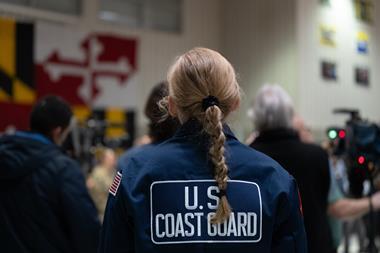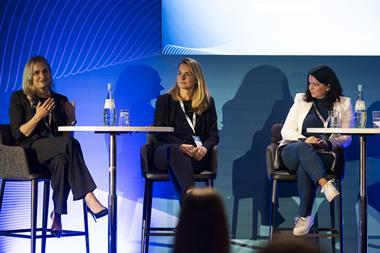Twenty American universities gathered in Detroit last week to give presentations on supply chain cases provided by General Motors, tackling subjects like sourcing battery cells in Asia to expanding rail links and supplier localisation in the US.

Wayne State, a public university based in Detroit, organised the competition, which was held at GM’s Renaissance Center global headquarters in downtown Detroit. A number of supply chain and logistics executives from major automotive companies judged the competition, including from GM, Lear, Denso, Delphi and Ryder. In the first round, students presented their findings and recommendations on an electric battery procurement question for a new plug-in hybrid vehicle the company will launch next year. Five teams selected to go through the finals were then asked to come up with a strategy for taking out $1 billion in logistics and material costs per year.
A chance to repaint a tarnished image
Bill Hurles, executive director for supply chain at GM, who has played an instrumental role in designing the cases and judging the finalists since the event began in 2011, told Automotive Logistics that the competition was not only an opportunity for students to learn more about the automotive industry, network and speak to recruiters, but equally for GM to showcase its talent in supply chain and logistics, as well as to improve the company’s image with younger people following its bankruptcy and government bailout in 2009. The three-day event featured interview slots for the participants as well as a tour of GM’s nearby Detroit-Hamtramck plant, as well as social and sporting events in Detroit.
“We are committed to supporting the education of young people. We want to promote innovation, and we hope that the students will consider our company and our products,” said Hurles. “The reputation of GM had been tarnished, and this is an opportunity for young people to have a different point of view of the company and the community.”
The competition now features more universities from states both within and outside the country’s traditional automotive heartland. While there were a number of schools from Michigan and Ohio that have prominent supply chain departments that deal regularly with the automotive industry, including Michigan State, Wayne State, Miami Ohio and Ohio State, there were also schools from Florida, Tennessee, North Carolina, Washington DC and New Jersey.
"The reputation of GM had been tarnished, and this is an opportunity for young people to have a different point of view of the company and the community" - Bill Hurles, General Motors
A number of students arrived at the competition with more interest – and in some cases, firm job offers – in industries ranging from oil and gas to high tech and agricultural equipment. But the opportunity to better understand the automotive industry and its supply chain may have won over at least a few. On the winning Toledo team, for example, while three of the four students are either working for automotive companies or have done internships alongside their degrees, Justin Blake, a senior (final year) with majors in supply chain management and finance, admitted that he hadn’t considered automotive before the competition.
“I was blown away by the plant tour,” he said, “especially the complexity and the amount of money floating around in the plant operations, and the way that minutes can be worth thousands of dollars.”
Electric options
This was the second year that Automotive Logistics has covered the supply chain competition, and during both years GM and the event’s other supporters assigned the students purchasing and supply chain problems that were very close to real business scenarios. While last year students had to analyse the risks and rewards of pulling forward production of the Chevrolet Malibu Eco (something that GM had recently done), this year they were confronted with a procurement decision for electric batteries.
In the case, GM must decide between launching its luxury, plug-in hybrid vehicle, the Cadillac ELR, with the existing battery used by the Chevrolet Volt, or using equipment from a fictional Indian supplier of battery cells, BrUS, that would offer 40 miles more per American gallon (about 5.9 litres per 100km) than the Volt option.
The Volt battery is assembled in Brownstown, Michigan, close to the ELR production plant in Detroit-Hamtramck, while the Indian option originates in New Delhi and would require a complex supply chain. Ultimately, the teams had to make recommendations between maintaining current supply, importing fully built up batteries from India, or importing the cells for assembly in Mexico, Brownstown or directly at Detroit-Hamtramck.
The case provided the teams with logistics and assembly costs to consider, investment requirements for upgrading plants as well as risks for a shorter-than-usual validation period. It also provided sales and profit forecasts between the different battery options.

The case had a strong grounding in reality. ELR production is starting early next year at Detroit-Hamtramck. While GM has not switched its battery supply from Browntown, the question of extending the range of the Volt or the ELR remains an important technological consideration. The complexity and cost that the case reflected in the potentially long, global supply chains also rang very true. The cells for the Volt battery built at Brownstown are provided by South Korea’s LG Chem, for example.
The student teams recommended a range of options, demonstrating the degree to which supply chain and purchasing decisions are rarely an exact science. Miami University of Ohio, which won last year’s competition but was beaten this year by Howard University in the first round, recommended that GM sourced its battery cells in India, but assembled the batteries in Brownstown, in part because the logistics and tariff costs of shipping fully built batteries would be so high. Howard, by contrast, calculated that the logistics cost and risk to disruption of using the Indian suppliers could be up to nearly $52.5m, while the upside net profit of the batteries was only $19m – and thus, not worth the risk.
But as GM’s Hurles pointed out, there was no right answer. Toledo’s analysis suggested that the highest profit would come from using the BrUS cells from India and assembling them in Mexico, before they are sent to Detroit, an option also reccomended by a number of other teams, including Michigan State. However, the Toledo team made several recommendations outside the scope of the case, including that GM should consider entering a joint venture or special licensing agreement with the Indian supplier that would eventually allow it to produce the cells and the batteries at Brownstown.
“That would eliminate most of the transport cost, disposable packaging and logistics risk from India to Mexico and Mexico to GM,” said Sasha VonSacken, a senior double major in supply chain management and information systems at Toledo, who is also a purchasing executive at Dana Corporation, a tier supplier.
The finalists
Five universities were selected to advance to the competition’s second and final round: Colorado State, Wayne State, Howard, Florida State and Toledo. The case called for the students to come up with ways that Detroit-based carmakers could reduce material and logistics cost by $1 billion a year over the next few years, including considerations for transport, inventory and sourcing decisions.
Although the case did not ask students to focus only on GM, it had clear echoes of a current objective at the carmaker. Earlier this year, GM’s vice-president of global purchasing and supply chain, Grace Lieblein, announced that the carmaker would target cuts of $1 billion in its annual material and logistics bill by 2016.
Sources at GM have told Automotive Logistics that the full target for the company is $1.5 billion in material costs and $1 billion in logistics. GM spends between $8 billion and $9 billion annnually for logistics around the world.
The Toledo team was made up entirely of seniors: Justin Blake, major in SCM and finance; Sasha VonSacken, SCM and information systems major; Emily Burghardt, major in SCM with a minor in information systems; and Athreya Rajan, a SCM major with a minor in international business.
All of the Toledo students were keen to pursue opportunities in the automotive industry. Like VonSacken, Rajan is also working for Dana Corporation concurrent to doing his degree. Burghardt, who has interned with Ford, said that the automotive industry was “everywhere around us” in the Toledo region. “It’s the heart and soul of Michigan and Ohio,” she said.

VonSocken admitted that it was difficult to make business arguments from a purely environmental standpoint, but he said he believed that companies would embrace more environmental practices when they make financial sense, with the automotive industry already ahead in some regards.
“In the automotive industry especially, reducing our fossil fuels and carbon footprint can be synonymous with higher profitability,” he said.
Like other university teams, Toledo also called for a greater focus on supplier relations. Both VanSocken and Rajan agreed that relations between buyers and sellers in automotive could be strained, but that they had seen signs of progress in their own careers. “I think there will be more consolidation of the supply base and more cooperation and strategic partnerships between OEMs and tier suppliers,” said VonSocken.
“The relationship between buyer and supplier can be especially brutal if you don’t know what you’re doing,” said Rajan. “But what I’ve learned from watching my superiors [at Dana] is how accommodating they can be. Supplier relationships can be a make or break thing for automotive.”
Again, each team had varying approaches to cutting supply chain costs. However, there was a surprising amount of overlap between the groups. Almost all of the teams, for example, made a case for increasing supplier localisation at or near GM factories in the US. A number of teams, including Toledo, Colorado State and Howard, all pointed to localisation as both a cost saving strategy and for improving the company’s reputation and labour relations.
Perhaps following on the news earlier this year that GM had invested several million dollars to extend rail lines at Detroit-Hamtranck, there were also suggestions to extend rail lines further and to increase intermodal transport. The latter went along with calls to reduce carbon emissions and environmental impact. For example, Wayne State called for using more rail and returnable packaging to cut costs and emissions. Both Toledo and Colorado State pointed to the possibilities of new technology that would reduce weight, saving on both emissions and shipping costs.
Supplier relations
Another common theme was a focus on improving supplier relations and increasing collaboration. Toledo recommended creating both a ‘joint continuous improvement’ programme that would help suppliers as well as to encourage them to suggest new ideas. The team also suggested a preferred supplier programme that would influence both operations and the carmaker’s approach to bidding and contracts. Florida State recommended a rewards system to share cost reductions with tier suppliers, as well as an awards programme.
Colorado State, meanwhile, recommended that GM create a supplier relation programme that would focus specifically on bringing lean manufacturing and logistics practices to tier two suppliers. It also suggested that the OEM create a ‘swot’ team to deal with logistics and supply issues. Similarly, Howard University called for GM to create a logistics ‘command centre’ within its supply chain organisation that would help to both develop supplier performance as well as to address critical issues or potential crises in the supply chain.
Several university groups saw potential for carmakers to pull together their supply chain resources. Howard suggested the creation of the ‘North American Logistics Alliance’, which would be open to carmakers and tier suppliers to find opportunities to combine and share more volume in the supply chain. Wayne State floated the idea of a ‘super distribution centre’ in the Detroit region that could be shared across the Detroit three and their tier suppliers. The team chose to locate the hub in Warren, north of Detroit and central between a number of GM, Chrysler and Ford facilities.
While a number of teams pointed to improving forecasting in the supply chain, Florida State recommended the implementation of a wide-ranging material track and trace programme, that would see every part package labelled with a QR code and scanned at various points in the logistics chain.
No silver bullet
In the end, although there were similar ideas between the teams, the judges thought that Toledo had pulled together the most comprehensive analysis and accounted for potential positives and negatives to the greatest extent. “Toledo nailed the fact that it is going to take multiple items, and that there is no silver bullet when it comes to supply chain costs,” said Bill Hurles. “They were very specific and they recognised the pros and cons, such as for both localisation and increasing rail.”
Hurles, recognising the degree to which themes of localisation and ‘reverse globalisation’ were discussed in the case presentations, agreed that the idea of near-sourcing or re-shoring suppliers to the US or North America was becoming a common topic in the industry and for GM. But he pointed out that it’s not always as easy to execute as the students might think.
“Suppliers need to make investments too, and try to find their own economies of scale that might get lost if they have too many low volume plants,” he told Automotive Logistics.
Revealing the extent to which GM is wrestling with these questions in its own operations, Hurles cited real life example where he thinks the common topics of supplier collaboration and localisation among students could have real application. At GM’s plant in Gravatai, in southern Brazil, 16 suppliers are onsite at a supplier park at the plant. However, Hurles suggested that this integration could go even further.
“Currently these suppliers are all working out of different buildings. But why not share one structure, one heating and electrical system, instead of all the separate costs?” he told Automotive Logistics. “By sharing one building, we could also get suppliers even closer so that we could just pull material from them rather than using a tugger and conveyance system.”
Such localisation and supplier strategy will be further discussed this week at the Automotive Logistics Global conference in Detroit. For the first time, parts of the conference will be streamed live and participants from around the world will be able to view presentations as well as interact with panels via questions and comments. Use our live site to follow the event and read live tweets and coverage.






















